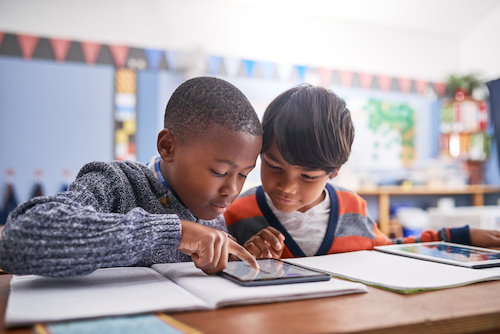Key points:
- Gamification can encourage students to take ownership of their learning
- Discover the different gamified resources one teacher uses to engage students
- See related article: Are you teaching with Minecraft and Roblox? You should be
Gamification is one of the biggest in education trends right now in education. According to ISTE, “Gamification is about transforming the classroom environment and regular activities into a game” (Haiken, 2021). Many students want more than just good grades from school–they want something physical or immediate. “Gamification empowers students with the ultimate in choices when setting goals for what badges and achievements they want to complete, which leads to learners building skills for self-reliance and self-control” (McCarthy, 2021).
Embracing gamification in the classroom will lead to students taking responsibility for their learning while also enjoying their time in class.
Here are three examples of gamification I use in my fourth grade classroom:
1. Gimkit: My students absolutely adore this game. They are constantly asking if there is a kit they can play. Gimkit is a game that can be played live or assigned to students as homework. Teachers create kits with questions for their students. There are multiple ways to play with those questions.
There are 2D modes, where the students have characters called gims, and they play
collaborative games such as Tag or Capture the Flag. There are also non collaborative games like Farm Chain and Fishtopia. The questions in each kit are used to help the students get energy to be able to complete the tasks at hand. If they do not answer questions correctly, they will run out of energy and won’t be able to move.
Apart from the 2D modes, there are also game show modes where the students have to answer as many questions correctly as they can and to earn points towards the tasks in each specific mode.
Gimkit is a super fun way to have your students learn through repetition and competition. I use them in my classroom as homework so the students can play and complete tasks at home, as well as in school to review concepts or questions on an upcoming test.
2. Kahoot!: The ever-loved Kahoot has become a fan favorite way to gamification in classrooms all the way from elementary through higher education. Much like Gimkit, teachers create sets of questions in Kahoot! and display them to their students in a game show format.
Students get points for answering questions correctly, and can earn extra points based on how quickly they answer. Classmates are competing against each other to see who can get the most points by the end of the set of questions.
One of my favorite features of Kahoot! is the discover page. On this part of the website, sets of questions are already made and ready to be used by anyone. Some sets are made by other teachers, while others are from companies like Disney, National Geographic, and NASA.
These sets come in handy in a pinch and it can be so nice as a busy teacher to not have to take the time to create a whole set of questions yourself–especially if someone has already done it!
3. Prodigy: Last, but certainly not least, Prodigy is one of the biggest up and coming ways to use gamification in a classroom. Prodigy is a website that is split up into two different game modes. According to the website, “In Prodigy Math, students are wizards engaged in epic math battles. In Prodigy English, students collect and harvest resources to build their very own world” (Prodigy). Students are able to play with their classmates when they are at school and learn from each other as well as through the game.
One of the best things about Prodigy for teachers is that they have questions that align to curriculum standards from grades 1 through 8. There is no need to come up with questions for the students, because they are already provided. Teachers can assign questions from specific standards and monitor students’ progress on each question.
Parents can also access to Prodigy and are able to purchase the game for their
students at home. This is a wonderful way for parents to be engaged with their student’s learning and it’s a great opportunity for children to learn at home.
Gamification is a huge part of education in today’s world. According to the Smithsonian Science Education Center, “Using gamification to aid in cognitive development will allow an increase in the activity of the regions of the brain to allow for adequate development” (Smithsonian, 2016). There are so many different ways to use gamification in the classroom. I have given just a few of my students’ and my own favorites that are frequently used in my classroom.
References:
5 benefits of Gamification. Smithsonian Science Education Center. (2016, March 10).
https://ssec.si.edu/stemvisions-blog/5-benefits-gamification
Haiken, M. (2021, February 12). 5 ways to gamify your classroom. ISTE.
https://www.iste.org/explore/In-the-classroom/5-ways-to-gamify-your-classroom
McCarthy, J. (2021, December 13). Using Gamification to Ignite Student Learning. Edutopia.
https://www.edutopia.org/article/using-gamification-ignite-student-learning/
Prodigy. (2023). Free math learning game for kids. Free Math Learning Game for Kids | Prodigy Education. https://www.prodigygame.com/main-en/
Related:
How to use Minecraft Education in your classroom
MDM solutions and gamification make perfect interactive learning partners
- 4 ways to encourage play in education - April 25, 2024
- CoSN IT Leader Spotlight: Lisa Higgins - April 25, 2024
- It’s time to pay student teachers - April 25, 2024

